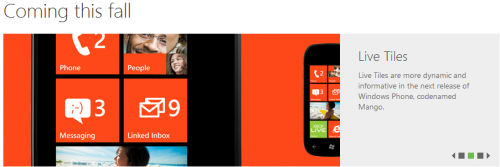Microsoft has sent its next iteration of the Windows Phone software to handset makers, as it wraps up the operating system’s features and software code ahead of a launch in Fall 2011.
The so-called Mango update, unveiled two months ago, promises a number of fixes and updates to the original Windows Phone, which looked great when launched late last year but had an uphill struggle taking on Google’s Android and Apple’s iOS devices.
Android is expected to power nearly half the smartphones in the market by the end of next year, with a share of 49.2 per cent, according to research firm Gartner. Apple iOS devices will take up 18.9 per cent share, it predicted, while Mango-based devices will occupy 10.8 per cent of the market in 2012, up from just 5.6 per cent at the end of this year.
In a blog entry earlier in the day, Microsoft said it had sent the Mango software code to “manufacturing” and is in the process of optimising the software for telco and handset maker partners. It is also preparing to roll out updates to existing Windows Phone users – a boon to those who have selected the path less travelled among smartphone software.
What’s great about Mango? Generally, it should bring the OS on par with, or even make it better than, its rivals. The first thing it adds to the an already smooth Windows Phone experience is multi-tasking. Current phones simply log you off MSN Messenger when a call comes in, for example, but Mango should be able to keep processes running the background.
Another handy feature, which is an extension of the tile system that makes Windows Phone easy to pick up for smartphone newbies, is the Threads feature. This which enables users to see all their conversations on chat, IM and SMSes on one screen.
Instead of opening several apps, Windows Phone has always been about linking up relationships with a friend, say, the photos where he is tagged with. This deep integration – a bold, different approach to Android and iOS’s app-based approach – is what Microsoft hopes would win over many first-time smartphone users.
Already, the first devices look promising. Fujitsu Toshiba showed off one such model today, as did Nokia in a “leaked” video last month. Not all is rosy, for sure. Other handset makers such as HTC and Samsung, however, have found success with Android and seem to have put Windows Phone somewhat in the back burner. Whether they will now put Windows Phone ahead of their Android models is still a big question.
Another tougher question is how much market share Microsoft can crawl back. Nokia CEO Stephen Elop, a former Microsoft executive, has bet big on building an ecosystem by going with Windows Phone and a quite spectacular device codenamed Sea Ray. He and Microsoft both need a big break with Mango in the upcoming holiday season, when folks will also be looking at an expected new iPhone 5 and several other updated Android models.






